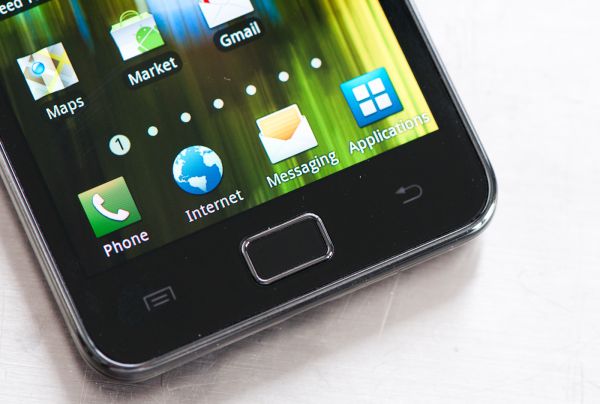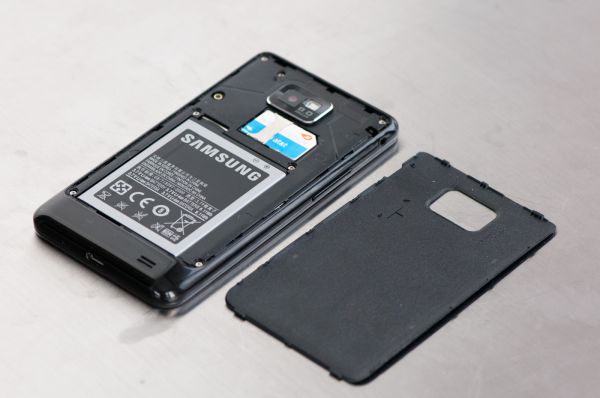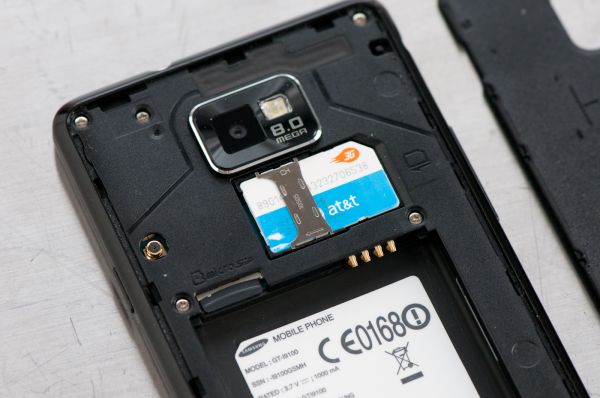Samsung Galaxy S 2 (International) Review - The Best, Redefined
by Brian Klug & Anand Lal Shimpi on September 11, 2011 11:06 AM EST- Posted in
- Smartphones
- Samsung
- Galaxy S II
- Exynos
- Mobile
Physical Impressions
The button arrangement on SGS2 continues the trend set by the international version of the original SGS, and eschews the search button, instead going with (left to right) menu, home, and back. Of course, regional variants are going to have different button arrangements, but this three-button approach seems to be a mainstay of the international market. When I hand the phone to most people, there’s usually a bit of confusion about what the home button does, and many mistake it for an optical or capacitive trackpad. Instead, the button is just that - a button. They’re backlit, and there are options to define backlighting behavior in the stock ROM - when in the dark, for a few seconds, and so forth.
Update: You can alternatively search by pressing and holding menu. Thanks everyone!
I have to be honest that continuing to shun the search button confuses me. Not just because not having it means we can’t run kwaak3 and get to console without lots of work, but because not having it made me realize how much I use it. Thankfully almost everywhere that I’d use the search button there’s a contextual shortcut - menu, then search. It’s just an added button press in the occasional spot, which can be alien if you’re used to having that button.
As I mentioned earlier, the battery cover is one piece of plastic which pries off and is held on with clips. It isn’t particularly sturdy, so thankfully getting the battery cover off isn’t a harrowing experience. Underneath is the SGS2’s large 6.11 Whr battery, microSD slot, and SIM slot. The microSD card can’t be accessed without a battery pull, and the card clicks in and clicks out. You can get the SIM out without a battery pull, however, and word has it you can even change SIMs without rebooting despite the prompts. At the very top is a ribbon antenna which is pretty evident, and below that is the camera module with adjacent LED flash.
There’s really not much to say about the phone with the battery cover off, everything is perfect here, and it’s clear just how much of the device’s internal volume is dedicated to the SGS2's relatively large 6.11 Whr battery.
Overall the SGS2’s in-hand feel is much better than its predecessor - it’s incredible how much a different back texture and 1.6mm of reduced waistline can make a phone feel. Where I waver back and forth is the weight department. The competition has largely gone in a design direction that employs metal and thus results in heavier devices. As a result, SGS2’s light weight seems to imply a certain level of cheapness where really there is none. I guess that’s the problem - even though SGS2 has metal internally for structure, the exterior is entirely plastic, and that’s what’s ultimately the material that sets user perception. The good thing is that though it feels light, SGS2 has solid build quality.
There are no rattles when the vibrator is going, no flimsy parts that might snap off or break (like the old microUSB door), and few places where dirt can encroach. There’s also very little flex. It’s impressively solid after you get over the hurdle that is its light weight.
| Physical Comparison | ||||||
| Apple iPhone 4 | HTC Sensation | Samsung Galaxy S | Samsung Galaxy S 2 | |||
| Height | 115.2 mm (4.5") | 126.3 mm (4.97") | 122.4 mm (4.82") | 125.3 mm (4.93") | ||
| Width | 58.6 mm (2.31") | 65.5 mm (2.58") | 64.2 mm (2.53") | 66.1 mm (2.60") | ||
| Depth | 9.3 mm ( 0.37") | 11.6 mm (0.46") | 9.9 mm (0.39") | 8.49 mm (0.33") | ||
| Weight | 137 g (4.8 oz) | 148 g (5.22 oz) | 119 g (4.20 oz) | 115 g (4.06 oz) | ||
| CPU | Apple A4 @ ~800MHz | 1.2 GHz Dual Core Snapdragon MSM8260 | 1.0 GHz Hummingbird S5PC110 Cortex A8 | 1.2 GHz Exynos 4210 Dual Core Cortex A9 | ||
| GPU | PowerVR SGX 535 | Adreno 220 | PowerVR SGX 540 | ARM Mali-400 | ||
| RAM | 512MB LPDDR1 (?) | 768 MB LPDDR2 | 512 MB LPDDR2 | 1 GB LPDDR2 | ||
| NAND | 16GB or 32GB integrated | 4 GB NAND with 8 GB microSD Class 4 preinstalled | 16 GB NAND with up to 32 GB microSD | 16 GB NAND with up to 32 GB microSD | ||
| Camera | 5MP with LED Flash + Front Facing Camera | 8 MP AF/Dual LED flash, VGA front facing | 5 MP AF, VGA front facing | 8 MP AF/LED flash, 2 MP front facing | ||
| Screen | 3.5" 640 x 960 LED backlit LCD | 4.3" 960 x 540 S-LCD | 4.0" 800 x 480 SAMOLED | 4.27" 800 x 480 SAMOLED+ | ||
| Battery | Integrated 5.254Whr | Removable 5.62 Whr | Removable 5.92 Whr | Removable 6.11 Whr | ||




















132 Comments
View All Comments
mbetter - Sunday, September 11, 2011 - link
Nice looking phone but after my last Sprint Epic turned out to be such piece of crap, I'm not getting burned again.jmcb - Sunday, September 11, 2011 - link
Sadly....this happened to me from the old Win Mo days with the Omnia 1. I kept up with the GS 1 and now the GS2...and I give Samsung credit for whatever pros the phones have.But like with any phone manufacture...a bad experience can have a lasting effect. And for me it was something simple: build quality and reception. Both were bad with the Omnia 1 IMO. And ever since....I've been leery of Samsung phones.
But...all n all the GS2 looks like more of a winner than the GS1.
warisz00r - Monday, September 12, 2011 - link
Eh, your loss. (you and the poster you're replying to)steven75 - Sunday, September 11, 2011 - link
...still doesn't have functioning GPS? Yikes!WinProcs - Sunday, September 11, 2011 - link
The GPS now works very well. It finds the satellites faster than any other smartphone I have tried including the iphone 4. Navigon is preloaded onto the phone (in Australia at least). The earlier version of Navigon had some problems on the Galaxy S. That appears to be fixed with the latest software version. The S2 has never had a problem with the GPS.I loaded Litening ROM and find that the phone is faster than original and battery life is much better too. I charge it every night but it is normally sitting at about 65-70% after an normal days use.
I had an iphone and a Galaxy S before the S2. It is better than both of those.
ph00ny - Sunday, September 11, 2011 - link
Are we reading the same article?"GPS works this time around, and works well. I took the SGS2 on a 7-hour long road trip with me and used its GPS continually with no issues."
Every review since the release has made it a point to check this and mentioned it clearly since the SGS1 debacle.
Reikon - Monday, September 12, 2011 - link
You missed the subject of the comment. He's talking about the original SGS, not the SGS2.JMS3072 - Sunday, September 11, 2011 - link
Does Hulu work using the Desktop user agent?Astri - Sunday, September 11, 2011 - link
Great review as always, but i was expecting to get more information about the famous color banding problem.Yes, the device is super etc etc, but its a pity to not be able to see everything on 24bit
supercurio - Sunday, September 11, 2011 - link
Hi Astri.In some conditions yes on Galaxy S II you can perceive gradient banding or suboptimal dithering.
The reason is not hardware at all, Super AMOLED+ controller and display work on higher bit-depth than 24bit, Gingerbread uses 32bit surfaces by default.
You can see 3 situations with degraded gradients:
- pre-dithered to 16bit or lower gradients or images
- web browser (automatic 16bit dithering)
- some games using 16bit without dithering instead of 32 on other phones.
Every available mDNIe preset apply a sharpness filter between the GPU and the screen itself. Of course, it doesn't play well with the 3 type of content listed before.
I reverse-engineered mDNIe controller registers to build a screen tuning app. Give a try to the dev snapshots: https://market.android.com/details?id=org.projectv... - root required.
The current version is basic but I'll offer complete rendering configuration in the end.
To avoid banding, use "Native" preset: as its named: no effect applied.